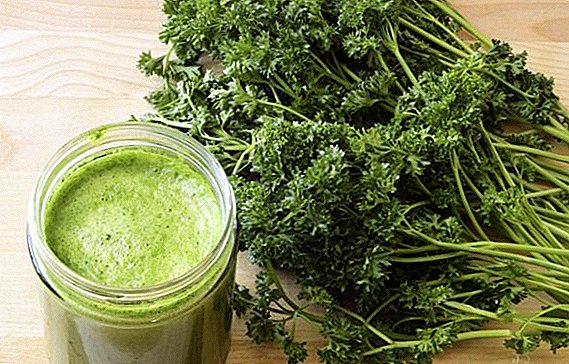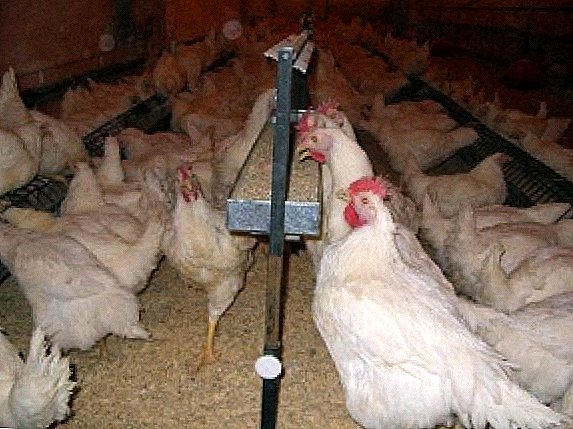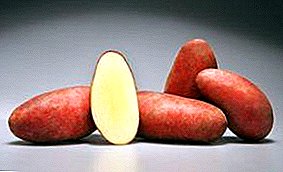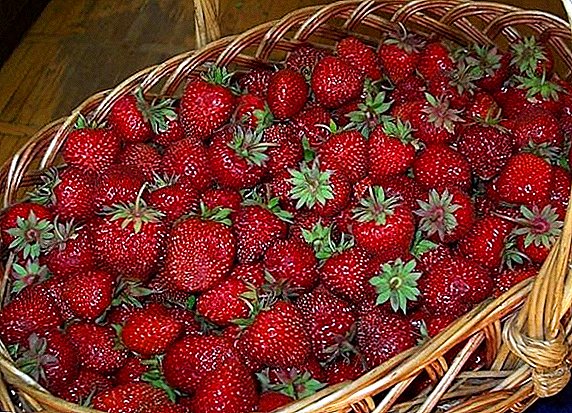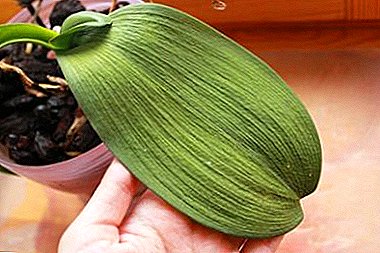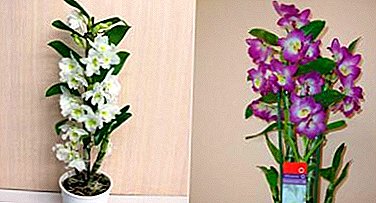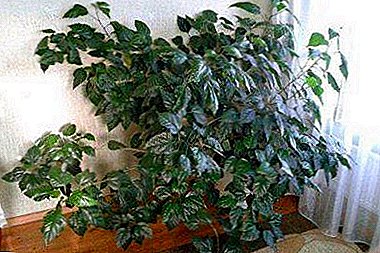 Tomato "King of Kings" is a complex hybrid (F1), popular among summer residents who seek to improve the yield indicators and grow truly large and fleshy fruits to their table. But it turns out this is not immediately and not for everyone, because for the safe maintenance of a varietal plant, careful consideration of all the rules is necessary - we consider them in the article.
Tomato "King of Kings" is a complex hybrid (F1), popular among summer residents who seek to improve the yield indicators and grow truly large and fleshy fruits to their table. But it turns out this is not immediately and not for everyone, because for the safe maintenance of a varietal plant, careful consideration of all the rules is necessary - we consider them in the article.
Variety description
Plants of the "King of Kings" variety are indeterminate tall and strongly branched shrubs, the growth of which should be limited by pinching the main stem to a maximum mark of 180 cm. The average foliar level, brushes begin to form after the ninth leaf, then every three-four.
Did you know? Peru is considered the birthplace of tomatoes, where this crop was grown long before the appearance of Europeans. Further (about 9 thousand years ago), tomato bushes began to cultivate tribes of local Indians in the rest of South America.
The advantages of the hybrid "King of Kings" include:
- high yields;
- beautiful, very large fruit;
- great taste;
- resistance to certain diseases;
- good transportability;
- long safety (up to 3 weeks).
 The disadvantages include:
The disadvantages include:- expensive cost of original seed packaging;
- the inability to use the fruit for pickling or preservation.
Fruit characteristics and yield
Hybrid "King of Kings" is characterized as a sort of medium late or late ripening. Approximately 120 days should pass from planting seeds for seedlings to harvesting the first crop. With proper shaping, timely watering and dressing, the level of yield can reach 5 kg of tomatoes from one shrub.
In addition to the tomato "King of Kings", late-ripening tomatoes also include: "Budenovka", "French Grape" and "Grapefruit".
Fruit Description:
- "King of Kings" is considered to be a giant variety - the weight of one fruit can vary from 400 to 1000 grams;
- up to 5 vegetables are formed on each flower brush;
- the shape of the tomato is rounded and slightly flat, the surface is ribbed;
- color is bright red;
- pulp is fleshy, dense, not too juicy;
- taste sweet, with unexpressed light sourness;
- each fruit contains from 4 to 8 seed chambers with thick and fleshy partitions.

Selection of seedlings
Seed hybrid material is desirable to buy in proven gardening stores that guarantee the quality of their products. In addition to checking the integrity of the packaging, the consultant should find out whether the seeds were pre-treated with disinfectants or other preparations. In case the seedlings are not cultivated by anything, the gardener will have to prepare it herself.
We recommend you to learn how to sow and grow tomato seedlings, when to plant tomatoes on seedlings and how to feed tomato seedlings.
Soil and fertilizer
Particular attention should be paid to the quality of the soil in which the acquired seeds will be placed, since further correct formation of tomato bushes may depend on this. The best option would be to buy ready-made soil labeled "for peppers and tomatoes," but if you want, you can prepare the soil mix yourself.
Important! Planting seeds "King of Kings" should not be made in the soil in which eggplants, potatoes, salad peppers and physalis used to grow.
Light, nutrient substrate (pH from 6.2 to 6.8) must consist of two parts of garden soil, 1 part of humus and 1 part of compost. Also, a small amount of wood ash should be added to the soil. Next, the resulting ground composition must be disinfected - put on a slow warming in the oven or pour over the pot with boiling water. 
Growing conditions
In addition to worries about the soil, an important point in the future of healthy sprouting seedlings are well-maintained conditions of detention:
- The air temperature in the room where the seedlings will develop must be maintained at + 23-25 ° C.
- To maintain good coverage of the seedlings can be placed on the south window sill or glazed balcony. If the windows of the room do not go to the right side, the tanks can be located on the northern part, additionally using fluorescent lamps (40 watts) for lighting. Above the landings, the bulbs are placed at a distance of 10 cm, the duration of additional lighting is 8 hours per day with a total lamp power of 120 watts per square meter. m
- The optimum indicator of air humidity is from 55 to 70%.

Growing from seed to seedlings at home
The process of growing strong seedlings from seed is divided into several important preparatory steps and necessary manipulations.
Seed preparation
Before sowing seeds into the soil, it is desirable to soak the seeds in a weak solution of potassium permanganate - the procedure will ensure their high-quality disinfection. After that, planting material is thoroughly washed with clean water and soaked in a growth stimulator for 24 hours.
Content and location
For future landings, it is necessary to purchase wide and shallow containers (containers or boxes) with drainage holes made.
After two large leaves appear on the plants, the saplings dive into large plastic cups or peat pots, not forgetting to periodically water and loosen the soil substrate. The location of the tanks is a south glazed window sill with good solar lighting. 
Seed planting process
To seedlings pleased amicable shoots, it should be placed in the soil at the same depth, with equal distance between the seeds. The optimum depth varies between 0.5 and 0.8 cm. After planting, the seeds are slightly sprinkled with clean water from a spray bottle.
Consider in detail the rules for growing and planting tomato seeds.
Seedling care
Proper maintenance of varietal tomato shoots is an important intermediate process before planting in open ground. Care involves the following steps:
- Watering. It is necessary to moisturize the seedlings 4 days after their germination, further manipulation is carried out in 3-7 days, depending on the humidity of the air and the soil, which should be slightly dried out. It is desirable to water the seedlings through the stalk, without touching the leaves, previously defended and warmed up to + 22 ° C with water.
- Organic fertilizing plants produce only 1 or 2 times, provided the soil mixture is correctly compiled. You can prepare the fertilizer yourself - insist a mullein (1 l per 10 l of water) or purchase a ready-made mineral balanced top dressing marked "for tomatoes".
- Approximately 10-15 days before planting in the ground shoots need to be hardened. The procedure is carried out in order to further shrubs hurt less and give the maximum yield. Sprouts of the "King of Kings" variety begin to harden only after 4-5 leaflets appear on them, as well as after setting a certain air temperature on the loggia and the street (in the daytime up to + 12 ° С). Initially, containers are carried out on the glazed balcony for only a few hours, increasing the time interval with each passing day, then the seedlings are left overnight for several days. Hardening on the street is carried out by the initial removal for 2-3 hours for 3 days, with each day, the residence time is increased by an hour until the plants stay on the air for the whole day.

Transplanting seedlings to ground
Approximately in 60-70 days, the friendly shoots of tomatoes can be transplanted to a permanent place, in our case - in open ground. The transplantation process is carried out in early May on a cloudy, but without precipitation day, based on the recommended scheme: for 1 square meter. m placed 3 shrubs at a distance of 40-50 cm from each other.
Step-by-step instruction:
- Holes are made in the soil with a spade bayonet.
- Pits generously watered with a dark solution of potassium permanganate.
- Lay, and then mixed with humus, 50 g of wood ash, 100 g of superphosphate, 30 g of potash and 1 tsp of magnesium sulfate.
- Tomatoes are deepened two times farther than in the tank.
- After disembarkation, shrubs must be watered abundantly

Agricultural technology of growing tomato seeds in the open ground
Transplantation of varietal seeds immediately after purchase also has its own characteristics. According to gardeners, this method does not differ in any way from the standard one, in which the procedure of preliminary sprouting at home is provided.
Outdoor conditions
The main condition for the maintenance of a hybrid in open areas is the correct choice of place for future plantings - it must be well lit and protected from the north wind.
You should also remember about undesirable neighbors for the “King of Kings” - peppers, eggplants, potatoes or tomatoes of other varieties should not grow near future plantations, while parsley, dill, cucumbers and cabbage will constitute a favorable neighborhood of seeds.  Because of the relatively weak resistance to cold, manufacturers recommend growing the variety "King of Kings" in open ground in Ukraine, Moldova, as well as in the southern regions of Russia. In the northern latitudes, plants can develop and bear fruit only in greenhouses or greenhouses.
Because of the relatively weak resistance to cold, manufacturers recommend growing the variety "King of Kings" in open ground in Ukraine, Moldova, as well as in the southern regions of Russia. In the northern latitudes, plants can develop and bear fruit only in greenhouses or greenhouses.
Did you know? The first description of tomatoes in Europe was made in 1555 in Italy, where they were called "tomatoes", which means "golden apple".
The process of planting seeds in the ground
The timing of sowing seeds in open soil is mostly dependent on the weather conditions of a particular region. If we talk about the southern countries and the central part of Russia, the landing may well take place already by the May holidays. Previously, sowing tomatoes does not make sense - the sprouts still will not sprout, waiting for the onset of warm days.  Landing in the ground should be carried out step by step, with the preliminary preparation of land and seeds:
Landing in the ground should be carried out step by step, with the preliminary preparation of land and seeds:
- about a day, the seeds should be placed in cheesecloth, which is then dipped in warm water (temperature up to + 29 ° C) for 3 hours. Next, the seeds are wrapped in dry gauze and laid out on the window sill, facing south (1 day);
- It is advisable to prepare the soil one month before planting the tomatoes - for this, the earth is well digged onto a full bayonet of a shovel and fertilized (3 kg of humus per 1 sq. m and 1 teaspoon of nitroammofoski). Next, the area is loosened, leveled and covered for warming up with plastic film;
- the seeds are laid in heated holes no larger than 1 cm in size, sprinkled with a 2-centimeter layer of soil on top. In this case, the material can be poured with a small margin (3-4 pieces each) - so, in the future, you can determine and select the strongest sprout, and remove the weak one;
- After sowing, the soil should be slightly compacted with hands, and then watered with warm water (1/2 cup per well).

Watering
Watering seeds planted in an open area should be as needed. Subject to the presence of fine days, moisture is made every 3-4 days, always with warm water under the roots of the plants. It is important to prevent the ingress of moisture on the trunks and leaves to prevent the development of fungal diseases.
Video: watering tomatoes and its features
Soil loosening and weeding
Loosening the soil in the tomato rows is carried out after each watering, together with weeding. In the first 2-3 weeks after planting, the loosening depth should reach 12 cm, then, in order not to accidentally damage the roots - about 5-7 cm. After the growth of shrubs procedure must be combined with hilling or bedding humus soil.
Masking
Grazing on shrubs of this variety is one of the main conditions for good development and rich yield.
To increase the yield of tomatoes they need to stepchild. Read how to properly form tomato bushes in the open field and in the greenhouse.
The process itself consists of pinching the tops of the stems (starting with the lower stepsons) until the formation of 1 or 2 stems. It is recommended to carry out the manipulation regularly, about 2-3 times over the entire growth period. 
Garter
The need for tying tomatoes is characterized in several points:
- fruits on tied-up plants get more sunlight and are much better ventilated;
- when ripening large tomatoes, the shrubs may not sustain their weight and break;
- fruits in contact with the ground are subject to frequent pest attacks.
Familiarize yourself with the rules for gartering tomatoes in the greenhouse and in the open field.
There are 5 most common ways of garter among gardeners:
- wire frame;
- pegs;
- horizontal trellis;
- vertical trellis;
- wire mesh and wire fence.
 For the "King of Kings" tomato variety, the horizontal trellis will be the most suitable way for the garter to hold the plants as they grow and prevent damage to the fruit. To organize the structure, it is necessary to dig in wooden stakes into the ground, and to stretch the twine between them. As a result, the tomato stalks are “let through” between several twine ropes.
For the "King of Kings" tomato variety, the horizontal trellis will be the most suitable way for the garter to hold the plants as they grow and prevent damage to the fruit. To organize the structure, it is necessary to dig in wooden stakes into the ground, and to stretch the twine between them. As a result, the tomato stalks are “let through” between several twine ropes.Top dressing
Every 2 weeks from the moment of germination of shoots, it is necessary to make complex balanced fertilizers (for example, nitroammofosku) under shrubs. In addition to the purchased product, fertilizing is produced by tincture of nettle, which maximally vitamins the soil and strengthens the immune system of the plants.
Read more about how to use nitroammofosku and fertilizer from nettle.
Also, to increase the number of ovaries on the bushes and better ripening of fruits, gardeners often make nitrogen, potash and superphosphate fertilizers. 
Pests, diseases and prevention
One of the nice features of the Kings King variety is its minimal susceptibility to late blight, but this does not give any guarantees of resistance to other diseases and attacks of pests.
Possible grade diseases:
- macroporiosis - a fungal disease that appears on the leaves of the plant in the form of rounded brown spots (1 cm in diameter) with pronounced concentric circles. Spots gradually merge into one and provoke complete desiccation of the foliage;
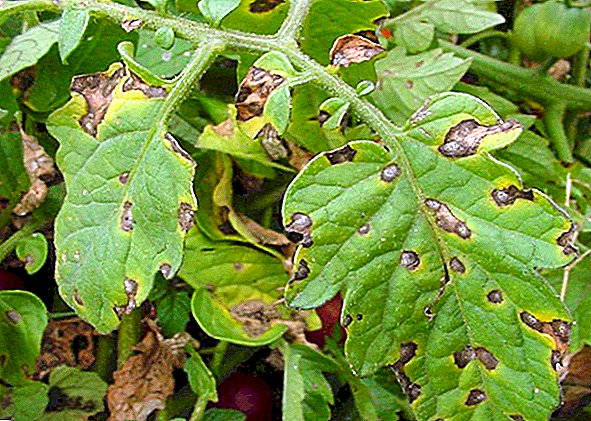
- tomato strick - viral infection, which is accompanied by the appearance of brown necrotic strips on the stems, and on the petioles and leaves brown spots of irregular shape;
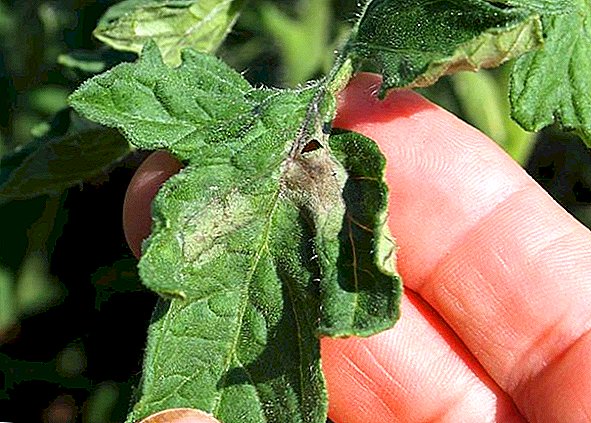
- gray rot - A fungal infection characterized by watery spots on green or ripening fruits. Later tomatoes rot and become covered with white mold;
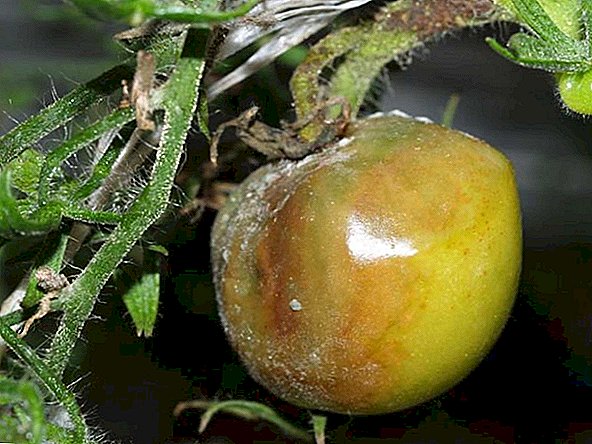
- physiological disease - twisting leaves. It develops in plants with a weakened root system, mainly from the lack of phosphate nutrition and the late removal of the stepsons. In addition to the strong twisting of foliage, the yield of affected shrubs significantly decreases.
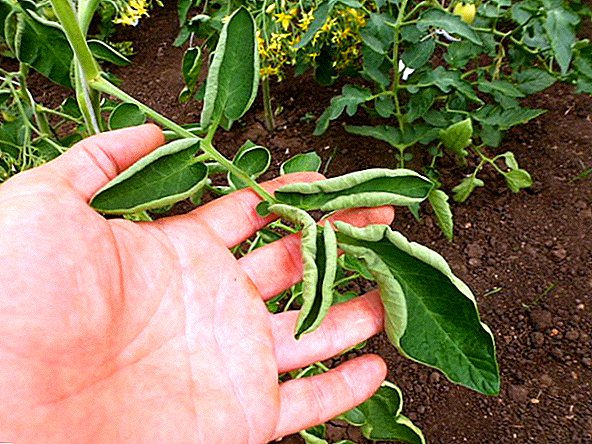
You will be interested to learn methods of pest control of tomatoes.
Preventive measures:
- preliminary disinfection of soil and seed before planting;
- maintaining proper irrigation and fertilizing;
- periodic spraying of garlic tincture with potassium permanganate, iodine and milk solution (15 drops of iodine per half liter of milk), decoction of wood ash, as well as professional preparations: Zaslon, Mancozeb, Brexil Sa, Glyocladinol, Flendazol ".
Harvesting and storage
Harvest should be in mid-August, always in the morning, after the dew has dried. Harvesting is usually carried out as the fruit ripens. If necessary, tomatoes can ripen after removal from the bush.  It is recommended to store vegetables in clean wooden boxes, the room should be well ventilated, and the air temperature should not exceed + 6 ° С. It is better to rinse the tomatoes, wipe dry and put in a box in tight rows. Under all conditions, the safety of the fruit can last up to two months.
It is recommended to store vegetables in clean wooden boxes, the room should be well ventilated, and the air temperature should not exceed + 6 ° С. It is better to rinse the tomatoes, wipe dry and put in a box in tight rows. Under all conditions, the safety of the fruit can last up to two months.
Important! Accurately determine the final ripening of the tomato will help the absence of a green rim around the stem.
Possible problems and recommendations
In addition to the problems associated with various diseases and pests, the gardener can face such an unpleasant phenomenon as the sudden fall of the ovaries with fruits and flowers from the tomato bush. The reasons for what happens can be unfavorable conditions of detention:
- watering with cold water;
- excessively high air humidity (over 80%);
- lack of nutrients (poor quality plant nutrition).
 If all the previously listed rules of agrotechnology are observed, conscientious care and timely prevention of diseases the risk of such a problem is reduced to almost zero.
If all the previously listed rules of agrotechnology are observed, conscientious care and timely prevention of diseases the risk of such a problem is reduced to almost zero.Growing tomatoes "King of Kings" in the open ground is not an easy task, but absolutely any gardener who invests the necessary resources, strength and soul into his planting can cope with it.






